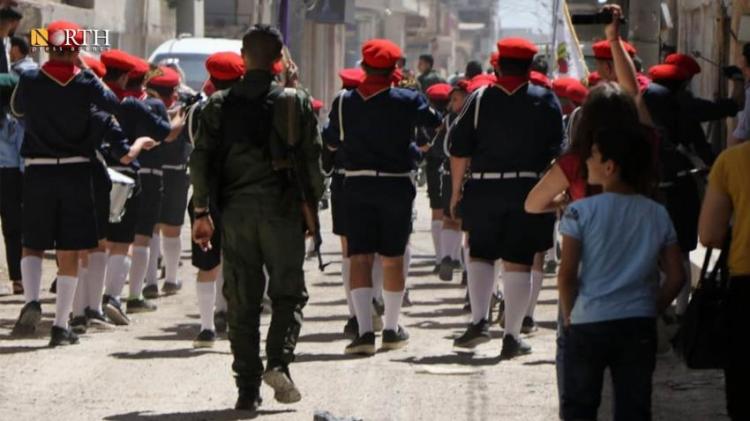AMUDE, Syria (North Press) – St. Elias al-Hayy church, which dates back to 1928, is one of the oldest Syriac churches built in the Jazira region during the massacres committed by the Ottoman Empire against Christians at the beginning of the 20th century. At that time, most Syriacs displaced from their villages who left their properties in the Mardin and Tor Abdin areas, southern Turkey, went to the adjacent areas in northeastern Syria, including the town of Amude, where the church was built.
The church was destroyed and remained abandoned for decades before Maurice Amsih, the bishop of the Parish of the Syriac Orthodox of Jazira and the Euphrates, decided to restore it, and he himself inaugurated it on July 20, 2018, coinciding with the feast of St. Elias at the Syriac Orthodox.
Reunion
The church witnessed a celebration of the feast of St. Elias, where a number of the townspeople who left it in different circumstances, so the church’s feast was an occasion to celebrate the memory of their restoration, as it was an occasion to reunite them, according to many who attended the celebration.
Engineer Kyork Moshekhian, who is from Amude and settled in the US in 2008, happily attended the festivities. He prefers working on his land rather than selling it or giving it to agents to manage it, and he stays in Amude for around six months a year.
Moshekhian remembers his childhood, which he spent part of in the churchyard, so he still keeps its details alive in his memory. “The length of the church from the inside 30m and width 13m, but its outer yard that we were playing in was 50m long and 44m wide.”
First migration
Moshekhian said that the first wave of emigration of the Christians from Amude was in 1958-1960, as a result of drought and limited job opportunities. The decline in agriculture and the lack of wheat seasons in particular led to the emigration of a large number of Christian families, who were more than 400 at that time.
During war years, regions of northeastern Syria witnessed a new wave of emigration that included various communities, but it affected the Christians more broadly, especially after Assyrian villages along the Khabur River were attacked by ISIS in February 2015, resulting in the kidnapping of more than 250 civilians.
Syriac sources say that Amude contained four churches of different denominations, namely the Syriac Orthodox, the Syriac Catholic, the Armenian Orthodox, and the Protestant or Evangelical Church.
A special prayer
In addition to bishop Maurice Amsih, who held a special prayer on Monday morning to mark the Church's Day, many priests and representatives of the Legislative Council and other institutions of the Autonomous Administration in the Jazira region, in addition to dozens who came to visit from various cities and towns nearby, attended the festivities.
“The Amude church was built by our fathers and grandfathers who came from Mardin, and surrounding villages in 1928. They built it hand in hand with the rest of the region’s communities; from Kurds and Arabs,” Amsih told North Press.
“Besides the church being historic, it is important to me personally because my parents were married and christened in it, and I am proud that I am from this town.”
Hope
After being inhabited by hundreds of Christian families, there are currently only six families left due to the migration waves, but their properties remain as they are, including homes and agricultural lands, despite the passage of ten years after the war, as the area maintained the coexistence among its communities to this day.
Amude resident Marin Yaqoub was drawn by the festivities to come and visit the town of her grandparents again, as she said.
Yaqoub, who spent her years in Qamishli after leaving Amude with her family while she was still a child, remembers visiting the town with her grandmother in subsequent years.
“Even after we settled in Qamishli, I kept visiting Amude with a grandmother repeatedly, and I visited the church when it was destroyed,” she told North Press.
“Upon the restoration of the church, I felt as St. Elias returned to live among us, and this would be a cause for the people of Amude to be reunited.”
Reporting by Reem Chamoun, editing by Lucas Chapman

